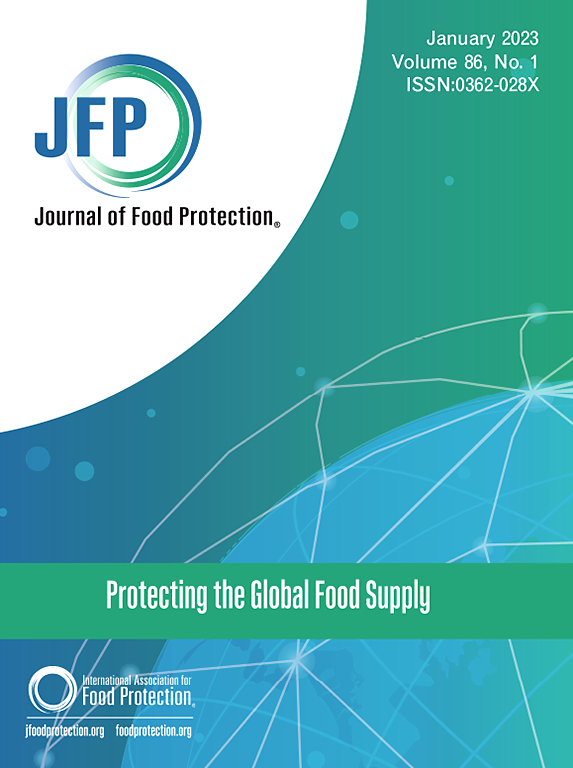A Machine–Learning Approach Reveals That Bacterial Spore Levels in Organic Bulk Tank Milk are Dependent on Farm Characteristics and Meteorological Factors
IF 2.1
4区 农林科学
Q3 BIOTECHNOLOGY & APPLIED MICROBIOLOGY
引用次数: 0
Abstract
Bacterial spores in raw milk can lead to quality issues in milk and milk-derived products. As these spores originate from farm environments, it is important to understand the contributions of farm-level factors to spore levels. This study aimed to investigate the impact of farm management practices and meteorological factors on levels of different spore types in organic raw milk using machine learning models. Raw milk from certified organic dairy farms (n = 102) located across 11 states was collected 6 times over a year and tested for standard plate count, psychrotolerant spore count, mesophilic spore count, thermophilic spore count, and butyric acid bacteria. At each sampling date, a survey about farm management practices was collected and meteorological factors were obtained on the date of sampling as well as 1, 2, and 3 days prior. The dataset was stratified separately based on the use of a parlor for milking, number of years since organic certification, and pasture time into subdatasets to address confounders. We constructed random forest regression models to predict log10 mesophilic spore count, log10 thermophilic spore count, and log10 butyric acid bacteria’s most probable number as well as a random forest classification model to classify the presence of psychrotolerant spores in each raw milk sample. The summary statistics showed that spore levels vary considerably between certified organic farms but were only slightly higher than those from conventional farms in previous longitudinal studies. The variable importance plots from the models suggest that herd size, certification year, employee-related variables, clipping and flaming udders are important for the spore levels in organic raw milk. The small effects of these variables as shown in partial dependence plots suggest a need for individualized risk-based approach to manage spore levels. Incorporating novel data streams has the potential to enhance the performance of the model as a real-time monitoring tool.
一种机器学习方法揭示了有机散装罐牛奶中的细菌孢子水平取决于农场特征和气象因素。
原料奶中的细菌孢子会导致牛奶和牛奶衍生产品的质量问题。由于这些孢子起源于农场环境,了解农场水平因素对孢子水平的贡献是很重要的。本研究旨在利用机器学习模型研究农场管理实践和气象因素对有机原料奶中不同孢子类型水平的影响。来自11个州的认证有机奶牛场(n = 102)的原料奶在一年内收集了6次,并进行了标准平板计数,耐寒孢子计数,嗜温孢子计数,嗜热孢子计数和丁酸细菌的检测。在每个采样日收集有关农场管理做法的调查,并获得采样日以及采样前1、2和3天的气象因子。数据集根据挤奶场所的使用情况、获得有机认证的年数和放牧时间分别分层到子数据集中,以解决混杂因素。我们构建了随机森林回归模型来预测log10嗜温孢子数、log10嗜热孢子数和log10丁酸细菌最可能数量,并构建了随机森林分类模型来对每个原料奶样品中耐寒孢子的存在进行分类。摘要统计数据显示,在经过认证的有机农场之间,孢子水平差异很大,但在之前的纵向研究中,孢子水平仅略高于传统农场。模型的变量重要性图表明,畜群规模、认证年份、员工相关变量、剪切和燃烧的乳房对有机原料奶中的孢子水平很重要。在部分依赖图中显示的这些变量的小影响表明需要个性化的基于风险的方法来管理孢子水平。结合新的数据流有可能提高模型作为实时监控工具的性能。
本文章由计算机程序翻译,如有差异,请以英文原文为准。
求助全文
约1分钟内获得全文
求助全文
来源期刊

Journal of food protection
工程技术-生物工程与应用微生物
CiteScore
4.20
自引率
5.00%
发文量
296
审稿时长
2.5 months
期刊介绍:
The Journal of Food Protection® (JFP) is an international, monthly scientific journal in the English language published by the International Association for Food Protection (IAFP). JFP publishes research and review articles on all aspects of food protection and safety. Major emphases of JFP are placed on studies dealing with:
Tracking, detecting (including traditional, molecular, and real-time), inactivating, and controlling food-related hazards, including microorganisms (including antibiotic resistance), microbial (mycotoxins, seafood toxins) and non-microbial toxins (heavy metals, pesticides, veterinary drug residues, migrants from food packaging, and processing contaminants), allergens and pests (insects, rodents) in human food, pet food and animal feed throughout the food chain;
Microbiological food quality and traditional/novel methods to assay microbiological food quality;
Prevention of food-related hazards and food spoilage through food preservatives and thermal/non-thermal processes, including process validation;
Food fermentations and food-related probiotics;
Safe food handling practices during pre-harvest, harvest, post-harvest, distribution and consumption, including food safety education for retailers, foodservice, and consumers;
Risk assessments for food-related hazards;
Economic impact of food-related hazards, foodborne illness, food loss, food spoilage, and adulterated foods;
Food fraud, food authentication, food defense, and foodborne disease outbreak investigations.
 求助内容:
求助内容: 应助结果提醒方式:
应助结果提醒方式:


